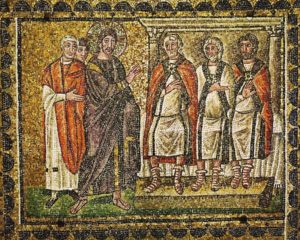Good Friday 2018
The synoptic Gospels agree on this. At the trial of Jesus before the Sanhedrin, Caiaphas challenged the charismatic sect leader Jesus of Nazareth whether he claimed to be the Messiah. Jesus said yes, he was. Mark 14: 61-62, NIV:
Again the high priest asked him, “Are you the Messiah, the Son of the Blessed One? “I am,” said Jesus. “And you will see the Son of Man sitting at the right hand of the Mighty One and coming on the clouds of heaven.”
This was the critical moment in Jesus’ two trials. The admission was an open-and-shut proof of blasphemy and led immediately to the first, and SFIK legally sound, conviction under Jewish religious law. The second trial and conviction by Pilate on the charge of sedition was a secondary put-up job to secure an execution, which the Sanhedrin either had no jurisdiction to impose or thought impolitic to carry out if it did.

Mosaic in Ravenna, 6th century Source
I’ve observed before that the omissions in religious art are sometimes as striking as the emphases. You don’t see many paintings of “Caiaphas versus Jesus.” Partly this is diffuse anti-Semitism. The scene is one of a balanced confrontation between two figures of authority – Jesus does not challenge the hostile High Priest the way he slights the sleazy apparatchik Pilate, the guy who controls the troops. Caiaphas is a baddie, but he has to be presented as a figure of dignity and substance. Much better to show nameless hook-nosed Jews sneering at Jesus as he’s flogged or crowned with thorns (the latter incidentally clearly part of the Roman stage-setting for the public destruction of a rebel). However, it’s mainly because the orthodox reading of the gospels has been that Jesus’ messianic claim was well established already, so the exchange with Caiaphas merely confirmed the already known.
But is that so clear? If you leave out John, an interpretation more than a history, the prior claims look ambiguous. The acknowledgement by Peter of Jesus as the Messiah in Matthew 16:15-16 and Luke 9:20 results from a question by Jesus to his close disciples: “Who do you say I am?” This is conventionally read as a test, and the passage continues in Matthew (but not Luke) with a confirmation. The question could just as easily have reflected uncertainty as policy. Elsewhere, after the transfiguration, Jesus orders the inner disciples not to divulge their vision (Matthew 17:9). Again, either explanation is possible.
The strongest evidence that Jesus had not made an unambiguous public claim is from the trial itself. Mark and Matthew recount that witnesses against Jesus came forward, but could not establish a clear case. The best shot was an indirect (and, according to the gospel writers, false) claim that Jesus had declared he could destroy the temple and rebuild it in three days. The Temple party had known about Jesus for some time and identified him as a major threat. In this it was supported by other factions (Pharisees and Sadducees) who had come into opposition to Jesus earlier. If Jesus had made a public claim to be the Messiah, this would have been common knowledge and the authorities would have found truthful witnesses easily enough.
So it’s a very plausible reading that it was only at the trial before the Sanhedrin that Jesus came clean. The moment was of extraordinary importance. Jesus could have walked back from the claim and quite probably saved his life, like Sabbatai Zevi.
This reading also makes more sense of the moving accounts of the agony in the garden at Gethsemane. On the traditional reading, the die is already cast. Jesus faces certain death, and struggles to come to terms with it. The synoptics say that the disciples both fell asleep and overheard Jesus pleading to God for a get-out-of-jail card. It’s possible, but something isn’t quite right, not just the overhearing. The natural reaction to inevitable doom is surely to huddle with your friends for comfort. You go off by yourself when you are struggling with a fateful decision. On my reading, how to respond to the Sanhedrin about the messianic claim fits perfectly. Jesus was deciding whether to confirm it and die, probably horribly, or walk it back and live.
Notes
1. The above takes a mainstream conservative Christian approach that the synoptic gospels are reasonably accurate while John should be taken, as history, with a pinch of salt. I’m not going to argue this position. If you take the line that the synoptics are also basically theological meditations loosely connected to historical events, or more radically that Jesus of Nazareth is a fictional character, my problem has no meaning. I will just observe that the reliability of a text and its internal coherence are not independent. A text should be judged by its most coherent internal interpretation, not polemically by its worst.
2. I trust I have not offended any reader by this little essay. It is not proselytising, though it comes from within a Christian tradition. It may serve as a topical reminder that “Christian” and “ignorant idolatrous bigot” are not necessarily synonymous.
3. Where I do plead guilty is to the longstanding Christian vice of engaging in the enjoyable pastime of speculating about the person of the founder of my religion rather than the harder work of living as he recommended. Given this long history, it is most unlikely that my speculations are original. I apologise to any unrecognised predecessors, whether Gnostics, Cappadocian Fathers, or Unitarian divines.
Leave a Reply
You must be logged in to post a comment.